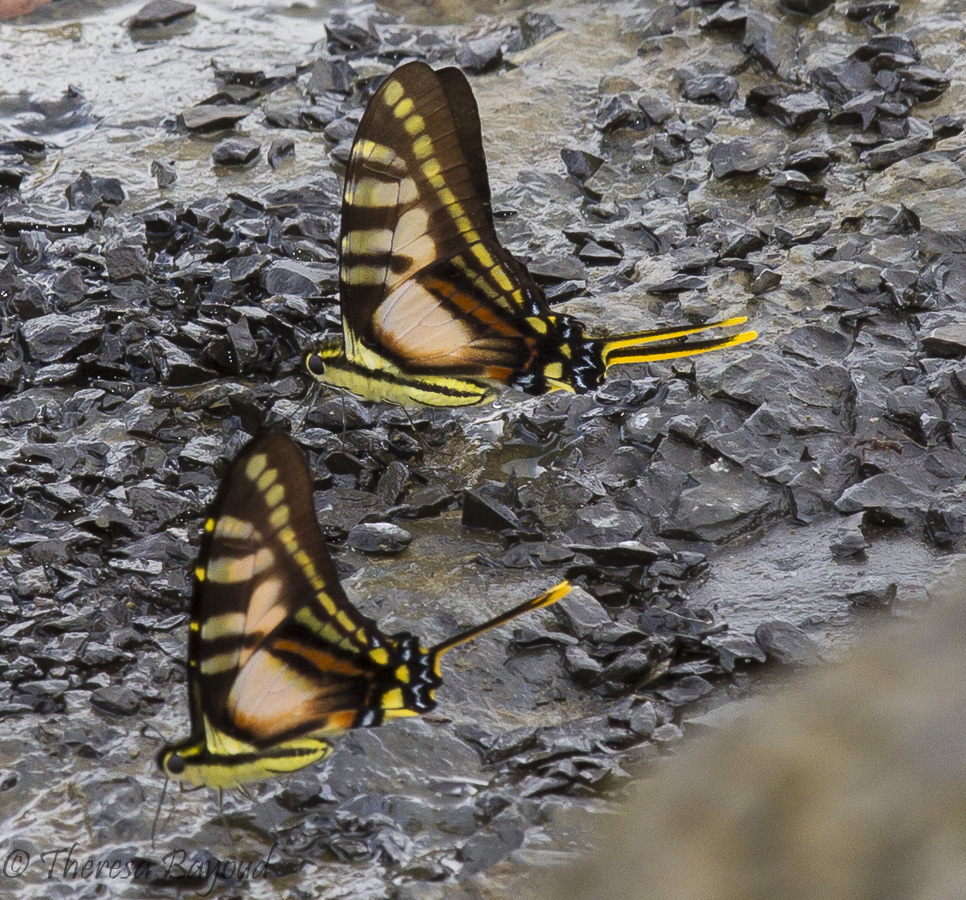Eurytides thyastes is a long-tailed Kite Swallowtail found from Mexico to Paraguay and in all the countries between. Abundant in some of its range, it's never appeared to be in any danger. Its wings are a bright school bus yellow that some even call orange, and they call this species the Orange Kite. The head and upper thorax are black with a row of yellow spots along either side, nd the rest of the body is yellow with a row of black spots.
Only recently have South Americans discovered the international market for photographs of these butterflies. Photos of males "lekking" (and licking) at puddles are abundant; they show that although male thyastes aren't always averse to the company of their own kind, they're more often found as the only one of their species in a mixed crowd of mostly smaller butterflies.
Photo by Blubayou, who snapped it in Ecuador in July. Although the butterflies can only stand and sip very shallow water, they're attracted to fast-moving, well aerated water.
Male Swallowtails are notoriously hard to photograph well; females, spending more of their time looking for host plants on which to lay eggs, seem rarely to be photographed at all. They "zoom" over treetops, flutter their wings even when sipping water or flower nectar, and apparently enjoy basking in the mist at spectacular waterfalls humans dare to approach only by helicopter/
Five subspecies are currently recognized: E. thyastes thyastes, found in Brazil and Paraguay; E.t. marchandii, found in Mexico, Guatemala, Honduras, and Belize; E.t. occidentalis, found in western Mexico; E.t. panamensis, found in Panama, Costa Rica, Bolivia, and Ecuador; and E.t. thyastinus, found in Ecuador, Colombia, Peru, Bolivia, and some localities in Brazil. They're all yellow with slightly different configurations of black stripes and spots. (People have thought for a long time that it was funny that Nicaragua wasn't on that list. Yes, thyastes have been found in Nicaragua.)
Of these, Rothschild classified marchandii as a separate species, panamensis as a subspecies of marchandi. He also raised the question whether the yellow color darkens with age, which seems still unanswered. And other early writers were downright emphatic about the belief that marchandii was only "remotely related" to thyastes.
Photo by Robert Gallardo, documenting how dramatically this species' underwings fade. Gallardo has written a guidebook and guided tours for "butterflying" in Honduras.
There has been some debate about the name, with people wanting to reclassify this species into new genera to be called Protographium, Neographium, or perhaps Eurygraphium. I found about equal amounts of worthwhile content by searching for Eurytides thyastes and for Neographium thyastes.
Why thyastes and thyastinus? Who was Thyastes? The first Swallowtails named were traditionally named after heroes of ancient literature. Google doesn't recognize the name or story of Thyastes. When not reading Thyastes as the name of a yellow butterfly found in South America, Google goes to the story of Thyestes. Thyestes and his brother Atreus were not heroes, even of the tragic kind. They were probably not real people, but just fictional definitions of everything the Greek writers believed was bad. Thyestes and Atreus behaved so vilely as to bring down curses on all their descendants until the family line was extirpated. They were cannibals, murderers of close relatives, child molesters, maybe other things too, anything that showed the lack of that innate moral sense that the Greeks thought distinguished humans from dumb animals. Their story was the kind of thing for which the ancient world invented the word "obscene," ob scaena, a story too ugly to be dramatized on stage. An actor might have been killed if someone thought he'd done the kind of thing a character like Thyestes did, so it became a traditional rule that nobody actually played a character like Thyestes.
Somewhere there ought to be a story about Thyastes, a completely different character, a soldier killed in a battle. a sailor who sighted land before anyone else did, something like that, but Google doesn't know about one.
A Eurytides thyastes is featured in this short, feel-good video:
Though not the stars of any scene, Eurytides thyastes are among the butterflies in Pedromariposa's slow-motion video:
Photographer Darrell Gulin sells possibly color-enhanced photos of thyastes sipping from colorful flowers, like this exuberant image now sold in Wal-Mart:
You can buy it at https://www.walmart.ca/en/ip/Purple-painted-tongue-flowers-with-Eurytides-thyastes-butterfly-Poster-Print-by-Darrell-Gulin-24-x-18-US48DGU1621/6VBUOOQL3SXV , and/or follow Gulin on Instagram for a chance to buy a print of a new picture.
Photo by Yanori_Santos, taken in March in Honduras. This kind of photo is less useful than the people who post it seem to think. We don't know whose hand the butterfly is perching on so we don't know whether the photo is telling us that the butterfly's wingspan is two inches or six inches. Relative to the other butterflies in mixed flocks it looks about three inches--about the size of the larger North American Swallowtails; much smaller than some tropical Swallowtails.
The life cycle of this species is not well documented. Herbert Miers reported that caterpillars eat leaves of the tree Talauma ovata. They have one generation each year, in that part of Brazil at least, and fly in October.
Photo from Butterflies of America, documenting that the caterpillars can share the pinstriped color pattern and humpbacked but smooth body shape of Eurytides/Boreographium marcellus and the whitish "belt" with many of the large, dark-colored Swallowtails.
Photo from Butterflies of America, documenting that a more fully camouflaged "bird dropping" look is also possible for this species.
David West described different color patterns in pupae, with black-and-white photos, in an article that has been preserved online: They have brown, green, drab, and dark forms.









No comments:
Post a Comment